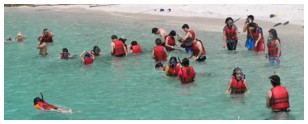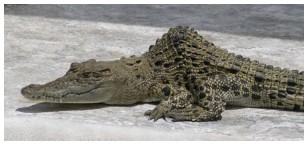|
Langkawi is a beautiful island
in the Northwest of
Malaysia, close to the border of
Thailand.
Actually Pulau Langkawi (as the Malaysians call their islands) is a group
of islands, some of them inhabited, and some not more than a bare rock in
the sea. We had a bungalow close to the sea, and we were on the right
side of the island to see a beautiful sunset every day, while sipping our
cocktails.
The brown eagle on the picture stands
overlooking the harbor of Kuah, the capital of the island, on the square
called "Dataran Lang (Eagle Square). My boys, good scouts as they are,
immediately recognized it as a Brahminy Kite. According to legends, the
eagle has given the island Langkawi its name, as "(He)lang" means eagle
and "kawi" means reddish brown. Real birds of prey are also visiting their
island frequently.
The name of the capital Kuah means "gravy" in Malay, and refers to a
couple of giants who spilled a large pot of curry as the result of a
fight, on the place where the city is now.
On a trip to the center of the island, we go up with a cable car to a
little more than 700 meters, and have a beautiful view over the sea and
the mountains. |
|
Close
to the main island of Langkawi, there are many reef islands with beautiful
fish. These places are the target of many tour operators, who empty their
bus loads of tourists on the beaches. And there are many tourists in
August: mainly from Arabia and from East Asia. Especially the latter group
enjoys these kinds of trips.
 One
of the islands is Pulau Payar, and we join in one of the tours.
Already on the ferry, many of the passengers start putting on life vests. I get a
little worried: is it possible we have to cross some wild waters, before
arriving to this beach? How will I get my little
Anna across that wild sea? But no need to worry, we arrive
perfectly normal on the shore; these people just don't know
how to swim. Even our little Anna is an expert compared to them.
In no time, the bay is littered with floating people in red vests, with
pipes sticking out of the water. A Titanic adventure with only survivors. One
of the islands is Pulau Payar, and we join in one of the tours.
Already on the ferry, many of the passengers start putting on life vests. I get a
little worried: is it possible we have to cross some wild waters, before
arriving to this beach? How will I get my little
Anna across that wild sea? But no need to worry, we arrive
perfectly normal on the shore; these people just don't know
how to swim. Even our little Anna is an expert compared to them.
In no time, the bay is littered with floating people in red vests, with
pipes sticking out of the water. A Titanic adventure with only survivors.
Already in the mid-nineties, a
report of FAO stated, that the tourists
were a major threat to the Pulau Payar Marine park. In 1995, over 70,000
visited the reefs and bay, and that number, according to FAO, should
definitely not increase, as the environment was already under serious threat.
On the day we were there, we saw hundreds of floaters, and a quick
calculation learns, that the per year amount of tourists has definitely
not diminished, if that is a daily event. The government has taken some
measures, however: part of the trip fee was a "Government Environmental
Conservation Charge", in the flyer of the tour operator euphemistically
called "Conversation charge". Not that it discourages people: there are
more red-clad tourists than colorful fish.
You do not have to be an environmental expert, to see what the effect of
the tourists is on the nature in the marine park. Not only are there
hundreds of them, coming to look for peace and quiet, but they also
exhibit interesting behavior. Their main activity is feeding the fish.
Almost all of them participate in the major activity: sharing lunch with
the fish. While they stand to their middle i n the sea, they feed pieces of
bread to the thousands of fish swimming in the shallow waters. Some of
them also feed their chicken legs to the fish, probably thinking that they
are entitled to a change in diet. n the sea, they feed pieces of
bread to the thousands of fish swimming in the shallow waters. Some of
them also feed their chicken legs to the fish, probably thinking that they
are entitled to a change in diet.
The fish no longer behave like proper fish. Pavlov-worthy, they know what
is lunchtime, and around 1.00 PM they move to the bay and look most like
water rats with fins; they jump out of the water to take the bread from
the tourist hand. Even though I do not feed them myself, I get bitten a
few times in my legs, which feels like the sting of a small bee.
The boys go out for snorkeling further down the bay. Not surprisingly, the
quality is disappointing. According to
Vincent, it is like “walking through a
wood where the trees have been chopped”. Still, I am not overly worried
when
Victor comes running out of the water, to
tell me he saw a shark. He has a vivid imagination and in this shallow bay
full of people, it must have been just an extra large normal fish. But he
was right, there are small black-tip sharks, whose quantity seems to increase
the more lunch time comes nearer. While the fish eat their bread and
chicken, the sharks eat the fish in front of our eyes.
Tourist operators however see the sharks
as a main attraction:
"There is a school of tame baby black-tip sharks in shallow waters just in
front of the Marine Park Centre which can be hand-fed by visitors". be hand-fed by visitors".
 Another
tourist attraction on the island, which seemed to me just as
controversial as the sharks, was the crocodile farm. What the attraction
existed of, remained unclear: on the one hand, their corkboard showed
newspaper clippings, telling how the Langkawi economy would boom because
of crocodile leather bags and shoes, produced by the farm; on the other
hand, the farm showed signboards at the cages, telling that the farm's
objective was to offer crocodiles a good place to live, even the invalid
ones. And indeed, there were some hunchback-like Quasimodo-crocodiles,
lying in the burning sun on a small concrete slab, wondering if this was
the dignified life they were promised to enjoy. Another
tourist attraction on the island, which seemed to me just as
controversial as the sharks, was the crocodile farm. What the attraction
existed of, remained unclear: on the one hand, their corkboard showed
newspaper clippings, telling how the Langkawi economy would boom because
of crocodile leather bags and shoes, produced by the farm; on the other
hand, the farm showed signboards at the cages, telling that the farm's
objective was to offer crocodiles a good place to live, even the invalid
ones. And indeed, there were some hunchback-like Quasimodo-crocodiles,
lying in the burning sun on a small concrete slab, wondering if this was
the dignified life they were promised to enjoy.
At quarter past eleven sharp it is "crocodile feeding time" at the
crocodile farm in and all visitors are encouraged to watch this
impressive spectacle. An enormous crowd of healthy crocodiles live in a
pond which would almost fit in our back yard, lying side to side with
their nose towards the border, like cars parked on the beach boulevard
on a sunny Sunday afternoon. The feeder opens the gate and enters with a
bucket, full of fish. He blows a whistle. The crocodiles seem deaf,
because only five of them show up. They finish the fish within two
minutes. When the bucket is empty, the man whistles again, and luckily
this time the crocodiles understand, and return quietly to their parking
lot.
But
obviously there are also many good things, on this clean island with its
friendly population. Nature on the island is beautiful and often unspoilt. Most of the tourists stay on the beaches, and the island has
not many inhabitants. Everywhere are beautiful flowers as well as views.
And the food is also a major attraction! |